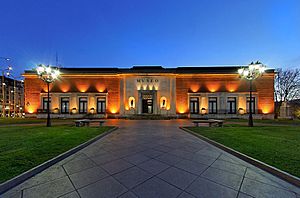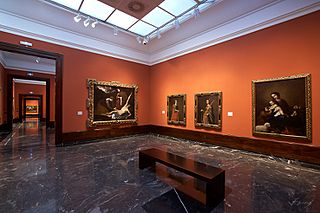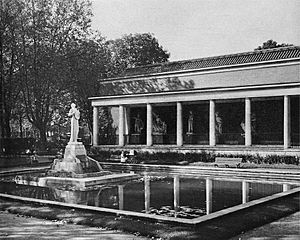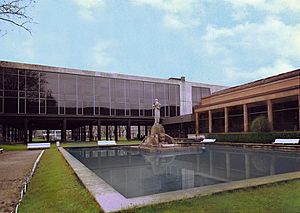Museo de Bellas Artes de Bilbao facts for kids
| Bilboko Arte Ederren Museoa Museo de Bellas Artes de Bilbao |
|

Front façade
|
|
| Established | 1914 |
|---|---|
| Location | Bilbao, Spain |
| Type | Art museum |
| Collection size | 10,000 items, 600 part of the exhibition |
| Visitors | 207,797 (2024) |
| Public transit access | |
The Bilbao Fine Arts Museum is an art museum located in the city of Bilbao, Spain. You can find it inside the city's Doña Casilda Iturrizar park. It is one of the most important museums in the Basque Country, second only to the Bilbao Guggenheim Museum. It also holds one of the best art collections in Spain outside of Madrid.
The museum has a huge and amazing collection of art from the Middle Ages to today. You can see paintings by famous old masters like El Greco, Cranach, Sofonisba Anguissola, Murillo, Goya, and Van Dyck. It also features more modern artists such as Mary Cassatt, Paul Gauguin, Francis Bacon, and Richard Serra.
Contents
Discover the Museum's History
The Bilbao Fine Arts Museum first opened its doors in 1908. After being in a few different places, its main building was finished in 1945. This building was designed in a grand, classic style. Over the years, it was made bigger in 1970 and again in 2001 to hold all the new art pieces.
The museum we see today was created by combining two older collections. The first was from the original Museo de Bellas Artes, which opened in 1914. The second was from the Museo de Arte Moderno (Museum of Modern Art), which started in 1924. In 2008, the museum celebrated its 100th birthday! Its motto was "100 Years of History, 10 Centuries of Art."
For over a century, people from the community, local artists, and public groups have worked together. This teamwork has helped the museum gather a huge and varied collection. It is now considered one of the most important in all of Spain. Many of its artworks came from generous gifts and donations from people who loved art. The museum also works hard to buy new pieces to make its collection even better. This means visitors can see a long and interesting history of art.
What is the Museum's Goal?
The museum is a public place for culture. Its main job is to collect, protect, study, and show its art collection. It also tries to add more art and keep its services excellent. By doing this, the museum helps educate people and share the cultural values of the Basque region.
The Museum Buildings
The First Fine Arts Museum
The Bilbao Fine Arts Museum was founded in 1908 and opened in 1914. The city wanted to become more modern and keep up with cultural trends. A main goal was to create a place that was important for any modern society. It also aimed to give local artists historical examples to help them learn and grow.
A big reason the museum started was thanks to Laureano Jado. He was a businessman and a kind person who left a large and valuable art collection to the museum. Other important donations soon followed from people like Antonio Plasencia. The Bilbao painter Manuel Losada also helped a lot to start the museum. He became the first director when it was located in the School of Arts and Crafts Village.
The Museum of Modern Art
Young artists in Bilbao started connecting with other art centers. They also saw more and more modern art shows, often put on by the new Association of Basque Artists. This made people in the city more interested in "modern art." Because of this, another museum was created just for contemporary art.
On October 25, 1924, the Museum of Modern Art opened. It was in a building that used to be a music school. This new museum had a very fresh and new way of thinking for its time. It was known for being up-to-date and taking risks with its art shows. This made it different from other museums in Spain.
A big event that helped start this museum was the International Exhibition of 1919. It was held in the "Berastegui schools" building. Many important artists from Spain and other countries showed their work there. The city council bought many pieces from this exhibition for the museum. These included works by Cassatt, Gauguin, and other Spanish artists. The Basque painter Aurelio Arteta became the director. He stayed in charge until the Spanish Civil War began in 1936.
The New Main Building
The Civil War affected the two museums differently. The Museum of Fine Arts moved its art to a safe storage place in Bilbao. But the artworks from the Museum of Modern Art had to be sent out of the country. After the war ended in 1939, it was very important to get these artworks back. Once they were safe, people realized they needed a new, single home for the museum.
In 1939, the County Council and the City Council agreed to pay together for a new building. It was built in what was then called the Park of the Three Nations, which is now Doña Casilda Park. Young architects Fernando Urrutia and Gonzalo Cárdenas designed the building. It was likely inspired by famous historical museums like the Prado. It used a mix of stone and red brick in a classic style. The building was finished in 1945. In 1962, it was named a "National Monument."
How the Museum Grew
To add a new part to the classic building, architects Alvaro Lebanon and Ricardo de Beascoa Jauregui updated the museum. They used simple, modern designs with materials like metal and glass. This new part opened in 1970 and has been used for modern art ever since.
The museum has also had many other updates and improvements. These added new spaces like an exhibition hall and an auditorium. They also created new services, such as departments for restoring art, cataloging, and education. There is also a library, a film library, a bookstore, and a cafeteria.
In the late 1990s, the Bilbao City Council and the Basque Government wanted to make the museum even better. They started a "Reform and Expansion Plan" in 1996. Under the direction of Miguel Zugaza, the goal was to improve the buildings and services. They added a connection between the old building and its new part, making sure both styles looked good together. They also changed the museum entrances to make them bigger and better for visitors. These changes were finished in November 2001.
Recent Updates
In December 2000, the city leaders created the Bilbao Fine Arts Museum Foundation. This group helps guide the museum and includes people who know a lot about art. In October 2008, the museum celebrated its 100th anniversary with the theme "100 years of history, 10 centuries of art."
In May 2009, the mayor of Bilbao, Iñaki Azkuna, talked about making the museum even bigger. Since it was hard to expand the main building again, they found a second place to store the newest art pieces.
Today, the museum has a total area of about 13,914 square meters. Over 5,000 square meters are used for the permanent collection in 33 rooms. About 1,142 square meters are for temporary exhibitions. The rest of the space is for staff and visitor services. Miguel Zugaza, who used to be the director of the Prado Museum, has been the director of this museum since 2017.
In 2019, two architecture companies, Foster + Partners and LM Urirate, were chosen to design the next expansion and update of the museum. This new plan will add over 2,000 square meters of new gallery space.
Explore the Art Collection

The Bilbao Fine Arts Museum collection is special because it covers a very long time, from the 12th century to today. It also has an amazing variety of artworks. The museum currently has more than 10,000 pieces! This includes about 1,500 paintings, 400 sculptures, over 6,500 works on paper, and 1,000 pieces of applied art.
These artworks are shown in 33 rooms for the permanent exhibition. The collection is divided into five main parts:
- Ancient art
- Modern and contemporary art
- Basque art (art from the Basque region)
- Works on paper (like drawings and prints)
- Applied arts (like pottery or decorative items)
The main part of the collection is Spanish art, both old and new. It also has many examples of Basque art from different time periods. The museum also has a lot of art from other countries, like Flemish and Dutch art from the 15th to 17th centuries. There are also unique pieces from Italy and some examples of Avant-garde and Post-Impressionism art. This helps put the Spanish and Basque art into a global context.
The collection mixes classic art (like works by Cranach, El Greco, Van Dyck, and Goya) with modern art (by artists like Bacon, Kitaj, and Serra). It also features art by Basque artists (such as Regoyos, Zuloaga, and Echevarría). The art is usually shown in time order, from the 17th century to the present day.
Special Collections
The museum has some very interesting special collections. These include the Palace collection of Oriental art and a collection of pottery from Manises from the 14th-16th centuries. There is also the Taramona-Basabe collection of ancient bronzes from different cultures, some dating back to the 6th century BC.
The Flemish and Dutch painting collections are very important. They include famous works by artists like Gossart, Benson, Coecke, Mandijn, Jordaens, Van Dyck, and Ruisdael. In 2012, the museum added an important painting by Lucas Cranach the Elder called Lucretia (1534).
The museum also has the largest collection of art by Basque artists. This makes it the most important place to learn about and see art from the Basque region.
You can also see a wide variety of works on paper, including prints and engravings. These are by famous artists like Albrecht Dürer, Rembrandt, Goya, Cézanne, Picasso, Duchamp, Hockney, and Bacon.
Images for kids
-
Washerwomen in Arles by Paul Gauguin (c. 1888)
-
The Virgin with the Child Jesus and the Child St. John by Francisco de Zurbarán (c. 1662)
-
Portrait of Martín Zapater by Francisco Goya (c. 1797)
-
Lot and his Daughters by Orazio Gentileschi (c. 1628)
-
Woman Sitting with a Child in Her Arms by Mary Cassatt (c. 1890)
See also
 In Spanish: Museo de Bellas Artes de Bilbao para niños
In Spanish: Museo de Bellas Artes de Bilbao para niños










